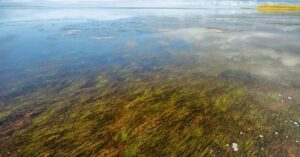PROVINCETOWN — As recently as 100 years ago, the shallow waters around Cape Cod were home to thriving eelgrass meadows. These lush, rippling green stretches of habitat were hotspots of biodiversity, home to an array of invertebrates and young fish that supported both the marine food web and the fishing industry.

Today, only a few of those meadows remain. A combination of nutrient pollution, habitat loss, disease, and damage from boating has reduced Cape Cod’s eelgrass beds by 90 percent in the last 100 years, according to Agnes Mittermayr, a marine ecologist with the Seafloor Mapping Team at the Center for Coastal Studies. She is also director of the independent international seagrass monitoring network called SeagrassNet.
On the Outer Cape, the meadows of eelgrass that once stretched from Long Point in Provincetown to Duck Harbor in Wellfleet have been greatly reduced, and meadows in Wellfleet Harbor and on Billingsgate shoal visible in the 1990s have disappeared, according to Mittermayr.
Now the National Park Service is beginning to restore eelgrass populations in Pleasant Bay in Orleans. The goal is to introduce only the most heat-tolerant grasses to resist future climate change. And a similar project is just getting underway in Wellfleet as well.
When an eelgrass meadow is thriving, it can support a wide variety of life. It serves as a nursery for young scallops, oysters, crabs, and fish like cod, allowing these animals to hide from predators as they develop. “Anything that’s smaller than the size of my palm starts out in the seagrass,” Mittermayr said. A single acre of seagrass can support 40,000 fish and 50 million invertebrates, she said. “It’s a very essential habitat that we don’t pay a lot of attention to.”
Eelgrass meadows also prevent erosion by holding sediment in place with their roots, Mittermayr said. And an acre of seagrass can also sequester 740 pounds of carbon per year — roughly the amount emitted by a car driving 3,800 miles, according to a description on the Smithsonian’s National Museum of Natural History Ocean website.
Of all the threats to local eelgrass beds, nitrogen poses the biggest one, Mittermayr said. Nitrogen enters eelgrass territory mainly through runoff from poor-quality septic systems. Once there, it promotes algal blooms that block light from reaching the plants, choking them out.
Eelgrass is also sensitive to physical disturbances like dredging, boat anchors, and propellers that tear up swaths of seafloor. Given time, the scars will grow over and seagrass will just move back in, Mittermayr said — “but if there’s a lot of them, the meadow eventually fragments and slowly disappears.”
Eelgrass also suffers because of high temperatures caused by climate change. At 25° C (that’s 77° F), eelgrass loses more energy maintaining its body processes than it can generate from photosynthesis. Water temperatures that stay above 28° C (82.4° F), Mittermayr said, would be the “cutoff” for eelgrass.
Mittermayr said the Earth is losing approximately one acre of seagrass every hour.
Restoration Projects
As part of her work with SeagrassNet, Mittermayr’s team is monitoring seagrass at three locations: one in Provincetown in front of the Harbor Hotel, one in Wellfleet near Duck Harbor, and one in Orleans in Pleasant Bay. They’re watching for its density, canopy height, and signs of disease; they’re also logging temperatures.
The Provincetown meadows are healthy, Mittermayr said, and the meadows in Pleasant Bay are doing relatively well, too. Still, they’ve declined by 50 percent since 1951 thanks to nutrient pollution, according to Alyssa Novak, a research assistant professor studying coastal ecology at Boston University who is also on the SeagrassNet team.
Novak is the lead scientist on a National Seashore eelgrass restoration project in Pleasant Bay that aims to bring back some of the acres lost there. The project is part of a broader grant-funded program to study seagrass recovery across seven national parks between Maine and North Carolina.
In selecting the areas in Pleasant Bay that would be restored, Novak mapped light availability, waviness, sediment conditions, and the presence of possible disturbances like docks, mooring fields, and horseshoe crabs.
But the most important factor, Novak said, is temperature. Since models suggest local sea surface temperatures will increase 2 degrees by 2050, the sites they pick need to be cool now — and there must be some chance they’ll stay cool later, Novak said.
This past September, eelgrasses from across the East Coast were transplanted by Novak’s team in Pleasant Bay. Once they see which ones thrive and which struggle, Stephanie Kamel, professor of marine biology at the University of North Carolina Wilmington, will sequence their DNA, hoping to identify genes the successful eelgrasses have in common and unsuccessful eelgrasses lack. The more heat tolerant strains can then be used for more widespread restoration.
It will probably be a few years before the restoration can begin in earnest, Novak said, but scientists hope these pilot studies will allow it to be as successful as possible. “It’s a system we’ve been monitoring; we understand it really well,” she said. “If anything changes, we’re on top of it.”
Novak and Mittermayr are also involved with an eelgrass restoration in Wellfleet Harbor that is just getting underway, led by the Center for Coastal Studies and supported by a National Park Service grant. This first summer, Mittermayr said, they began collecting preliminary data on factors like nutrients and light levels in the harbor to identify sites for restoration — the same kind of scouting that was done in Pleasant Bay.
The data collection and mapping will take three years, Mittermayr said, which would “lay the groundwork” for a restoration. Until the data is crunched, “it’s too early to say” whether a Pleasant Bay-style restoration is feasible in Wellfleet.
On a large scale, it’s hard to know whether the massive eelgrass beds that once ringed Cape Cod will come back, Novak said. But when it comes to benefits that eelgrass provides, like fostering fisheries, anchoring sediment, and sequestering carbon, even these small-scale restorations are important.



